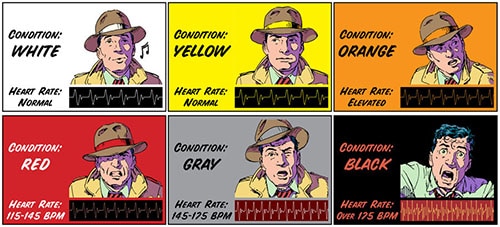kevin.k.woo
Shared posts
descant
New Dad Survival Guide: The Mindset

Yesterday we talked about the “skillset” needed by new dads. Things like changing a diaper and burping a baby will come pretty easily with practice. Keeping a positive mindset is harder, and much more important. Here are my suggestions for maintaining a healthy perspective and preserving your sanity after a baby bomb drops from the sky and blows up your old life.
New Dad Survival Guide: The Mindset
Realize you were made to do this. There’s a popular perception that being an involved dad is an entirely modern phenomenon — and that primitive men just deposited their seed and went on their way. But recent research on the neurological and physiological changes men experience before their baby arrives shows that male parental involvement is in fact deeply ingrained.
Three weeks before your baby is born, your testosterone levels will fall by about a third in preparation for you taking on a more nurturing role. (They’ll rise back to pre-birth levels about six weeks after your baby arrives.) At the same time, your brain will actually change too – becoming more adept at homing on a baby’s cries. As the researcher who discovered dads’ drop in T put it: “Raising human offspring is such an effort that it is cooperative by necessity, and our study shows that human fathers are biologically wired to help with the job.”
Contrary to the popular cultural stereotype of the bumbling dad who has to constantly be rescued by Mom, men can be just as competent at childcare as women.
Realize there’s no “normal” way to feel. People love the image of the man — especially one who’s typically tough and stoic – who cries upon first seeing his progeny. And guys will often talk about the overwhelming love they felt for their newborn as soon as it emerged from the womb. And if that happens to you, great. But realize there’s a whole host of different emotional reactions you might experience. I didn’t cry when either of my kids were born. I was just like, “Whoa, cool, there’s my baby!” I did feel a surge of love and pride when I first held them, but you might not even feel that. Instead your baby might seem like a weird stranger — a tiny alien that suddenly beamed down into your life. That’s okay too.
The feelings you have for your baby can be compared to a romantic marriage versus an arranged marriage. In the former, you fall in love first, and then make a commitment; in the latter, you make the commitment, and then fall in love. Both kinds can and do work just fine. So don’t worry about or think something is wrong with you if you don’t feel over the moon about your kid right off the bat – as you involve yourself in his life, your love for him will grow deeper and deeper with time.
It’s also very normal to have fluctuating feelings about your child after you take her home and as she grows up. I feel like there’s this idea out there that you’re going to love your child intensely every moment of every day. That’s decidedly not the case. You’ll always have a steady, unchanging love for them, but sometimes you’ll feel incredibly angry at them or just plain ambivalent. You’ll even have moments where you don’t really like them. Your love for your kid is like a little ember that’s always there, and sometimes explodes into a fire of overwhelming joy and pride, and sometimes smolders very faintly. All very normal.
Get hands-on right away. If you’re feeling awkward or unsure about being a dad, the best thing you can do is to ignore that feeling and spend as much time with your baby as you can. If you heed that awkward feeling and avoid the kid, it turns into a cycle where you feel more awkward so you avoid him more, making you feel more awkward, and so on. On the other hand, the more hands-on you get, the more comfortable and bonded you feel with the baby, and the more time you want to spend with him, and that becomes a virtuous cycle that keeps on increasing your confidence.
Be empathetic. A crying baby can be incredibly frustrating. One of the things that helped me stay calm was trying to put myself in my baby’s tiny, tiny shoes. I would think about the fact that these were their very first moments, days, and weeks on this planet, and that every single sight, sound, and smell was brand new. There’s plenty for a baby to be disoriented and upset by.
Even more importantly, I’d think about the fact that when something was bothering them, they had no other way to let us know except crying. Imagine if you felt sick or had an itch or had something scratching you, and you couldn’t do anything about it or ask anybody for help. It’s hard out there for a baby.
Realize they only get more and more interesting. Ernest Hemingway once said, “To be a successful father . . . there’s one absolute rule: when you have a kid, don’t look at it for the first two years.” Now I don’t endorse Papa’s tip, but it is true that while many women love babies, men generally enjoy their children more as they get older. Babies are cute, and sometimes I even have those moments where I wish I could keep them that little forever, but let’s be honest, they’re kind of boring. They’re these cute, but super stoic, unsmiling creatures who only sleep, eat, and poop.
But the good news is that they steadily get more interesting by the week. It’s amazing to watch them gain a personality and begin interacting with you bit by bit. The more they’re able to engage with you, the more enjoyable they become. (On the downside, the more they’re awake, able to control their body, and verbalize, the wider their arsenal of exasperating antics!).
Manage your expectations. Anger and unhappiness of all kinds generally have one root: a mismatch between expectations and reality. The more you think fathering is going to revolve around happily tending to a calm, smiling baby, the more frustrated you’re going to be every time she starts hollering. The more you set your mind that it’s going to be tough, the more you’ll be able to calmly roll with the punches.
This is especially important when it comes to their sleep schedule. Once they start sleeping through the night, it’s tempting to think, “Whew, this is great. Now things can get back to normal!” All goes well for a few months…then they wake up in the middle of the night because they’re teething or sick or who knows why. If you’re not prepared for this to happen, it can really bum you out. Count on it, and you’ll find it easier to deal. Don’t worry, they’ll get back on track again. (But don’t count on it!)
Embrace the challenge. I’d recommend going even further than the recommendation in the point above; rather than just accepting that it’s going to be hard, relish that fact a little. There are so few challenges in our modern life, that I really enjoyed and appreciated getting to weather this one. The more you see fatherhood as a challenge that will test your mettle and give you a chance to rise to the occasion, the easier it will be to maintain a positive mindset, and the more satisfying the experience will be.

We’re you’re feeling tired and rundown, it helps to keeps things in perspective. Being a new dad is hard, but it’s not say, Iwo Jima hard.
Keep it all in perspective. While it’s good to expect the worst, also realize that in the grand scheme of things, it’s really not that hard. There will definitely be times when you’re going to feel super tired and rundown from the late nights. To keep myself from sinking into despondency at such moments, I would think something like, “Well, at least I’m not tired from trying to stay awake in a freezing cold trench at the Battle of the Bulge….Right, this isn’t so bad. I can do this.”
Embrace this season of your life. When it comes to minimizing your frustration and maximizing your happiness with fatherhood, I cannot emphasize this point enough. It’s completely normal to have moments where you miss your childless life after you have a baby. But the more you concentrate on what you can’t do during this season of your life, instead of what you can do, the more unsatisfied and restless you will feel. Sure, you can’t go out with your friends as much, and doing pretty much anything involves a lot of rigmarole, but, you get to watch a human being’s development moment by moment and play a role in shaping that development. You’re holding a living legacy in your arms. That’s pretty awesome.
Realize that your kid is not going to “make” you happy. Studies showing that having a kid decreases your happiness get passed around a lot these days, but other research has in fact shown the opposite, and the results are actually inconclusive. If you’re worried about how your new baby is going to affect your happiness, keep two things in mind.
First, happiness is overrated. I realize this is a loaded statement that requires a lot more unpacking than I have room for in this post, but suffice it to say that your moment-to-moment feeling of well-being is much less important than your overall sense of satisfaction and fulfillment. If you asked a man who was in the middle of climbing Everest – a man in the midst of an incredibly painful and strenuous challenge — whether he felt “happy,” the answer would probably be no. But despite the pain, the climb is probably bringing him a deep satisfaction, and for the rest of his life, he will experience the fulfillment of being able to say, “I climbed that mountain.” Such is parenting.
Second, happiness is a choice, not something compelled by circumstances or your children. Blogger and dad Matt Walsh recently penned a brilliant piece on this truism. The whole thing is worth reading, but here’s a choice excerpt:
“My kids don’t make my happiness. That isn’t their job. My happiness isn’t a responsibility that falls on their tiny little shoulders. Kids come into this world helpless, naked, and needing, yet so many of us immediately shove them into the Happiness Factory and bark commands. “Get on the assembly line and build me some happiness! Quick! Do your duty, sir!” …
The joy and happiness of parenting is like the joy and happiness that can be found in many good things: it comes from sacrifice, self-denial, and self-giving. It comes with work and effort. I have to be the sort of person who finds happiness in giving, and I will not automatically be that sort of person just because I had sex and made a couple of babies. In other words, my kids don’t make me happy to be a parent; I have to make me happy to be a parent. And I am. I am beyond words. But that happiness will decrease if I become more selfish, and it will increase if I become less selfish. If you want your kids to make you happy, you are asking your kids to make you less selfish. That is a demand that is, all at once, incredibly stupid, laughably absurd, and profoundly abusive.
And then maybe we should stop worrying so much about this happiness thing, anyway. I think the happiest people are the ones who spend the least amount of time whining about their desire to be made happy. They do a thing because it’s right, or because they have a duty to do it, or because it is interesting, or beautiful, or enlightening. They choose to find happiness amidst it all, but that was never the point. They aim beyond mere enjoyment, pleasure and satisfaction. If your own happiness is the Alpha and Omega of your life, you’ll never do anything important or become anything significant in this world. Ironically, you’ll also never be happy.”
Keep doing the things you love. While trying to replicate your childless life once you have a kid is a recipe for frustration and poor parenting, you shouldn’t entirely give up the things you once loved either. Have a couple non-negotiables that you make it a priority to keep up, at least after the craziness of the first few months subsides.
Last month when I was rock climbing I saw a couple who brought along their 2-month-old and were happy as can be. I felt like shaking their hands.
Fitness has been something I’ve taken a lot more seriously this year, and I was back going to the gym every day two weeks after Scout arrived. I was super tired from the late nights, but it’s something I love to do and hate to miss. It helped buoy my sense of well-being, and it gave me a small sense of routine when the rest of my life was a little chaotic.
Isolating yourself in your house with just your baby and your wife and a cabinet full of junk food is not going make you feel good about life or fatherhood.
Keep up your relationship with your significant other. Speaking of holding on to the things you love, don’t let your relationship with your wife/girlfriend go to pot either. Your energies will definitely turn away from each other and towards taking care of the new arrival, and you won’t have much time to just hang out and enjoy each other’s company. And because much of your willpower will be depleted in restraining yourself from throwing the baby out the window, you’ll have less of it for controlling your behavior towards each other. You may find yourselves bickering more and being more prone to losing your patience with each other.
So it’s important to empathize with your partner’s state of willpower depletion, be more tolerant of their foibles, and carve out time — however short — to re-connect each day. If you work and your wife stays home, take the baby off her hands as soon as you come in the door. Watch some TV and do some cuddling and talking when the baby sleeps at night. Remind yourselves to stop and hug. Once her doctor gives her the greenlight after six weeks to resume sex, try to fit that activity in when you can. After a couple months, find a babysitter and have a date night.
The best possible thing you can do for your kid is to have a good relationship with his mother. Don’t neglect it.
This too, shall pass. Adopt this as your motto during this time. When you’re in the trough of the newborn phase, it can feel like the tiredness and stress are going to last forever. But of course it doesn’t.
A child demolishes the old structure of your life — the one that revolved around you — and it takes some time to build a new structure in its place – one that revolves around your child. Until the new structure is complete, life can feel a little shaky.
For my money, the lowest time is around the 6-7 week mark. You’ve had a month and a half of greatly disrupted sleep, the rush of having a newborn that kept you going the first few weeks has evaporated, and while the baby requires a ton of care, she isn’t giving much in return, unless you count blank stares and dirty diapers. You really have to run on duty and commitment rather than pure affection during that time.
But then things turn a corner. With any luck, your baby will start sleeping through the night around 8 weeks. Once you start consistently getting a full night sleep, you can handle any fussiness that arises during the day. She’ll start smiling around the same time too, and the first little hints of personality will emerge.
Around 6 months, the new structure of your life will have tenuously been erected. You feel much more confident and less awkward. Being a dad starts to feel like your new normal.
A year out, you feel like a pro, and being a dad is your new normal. As more and more months go by, you, your wife, and your son or daughter find a really happy groove and routine.
But by that time of course, it’s time to have another baby, throwing everything back into chaos! But next time around, you’ll be a seasoned veteran.
Best of luck to you on this incredible journey.
No related posts.
How to Escape a Sinking Car: An Illustrated Guide

 |
This post is brought to you by the T3 Tactical Auto Rescue Tool. It has everything you need to escape from a sinking car including a seatbelt cutter and window breaker. What’s this? |
Nearly 12% of the bridges in the United States have been deemed “structurally deficient” by the Federal Highway Administration. It’s scary to think that one might collapse while you’re driving over it, plunging your car into the water below. Becoming a victim of bridge collapse is hardly the only way to end up in a submerged vehicle, however. Many drivers simply skid out around a curve, go over a guard rail, and end up in a body of water. According to some studies, over 10,000 water immersion auto accidents happen each year.
Finding yourself in a sinking vehicle can be a terrifying experience and panic can keep you from being able to escape. Memorize these easy-to-follow tips so you can stay calm and get out quickly and safely if this ever happens to you.
For more details on escaping a sinking car, check out this post.
Illustration by Ted Slampyak
Related posts:
- How to Escape a Sinking Car
- How to Remove a Fish Hook from Your Finger: An Illustrated Guide
- How to Escape a Riptide
- How to Negotiate for a Used Car
- 9 Ways to Winterize Your Car
In a Pig’s Eye
The president’s Twitter account recently sent out this small dribbly contribution to the oceans of illiteracy that already exist out there. What’s another half pint?
Here’s how to improve our economy and create hundreds of thousands of jobs: #RaiseTheWage. http://OFA.BO/tXMYUq pic.twitter.com/UDTcTSaqZJ
So here’s the comeback, and I must say that it is hard to type and snort at the same time.
So why don’t we just raise the minimum wage to a hundred dollars an hour and make everybody well off? Or, while we are in this compassion groove, why don’t we make it a hundred dollars a minute and make everybody fabulously wealthy? To reply that employers don’t have that kind of money to spare is to betray a churlish spirit, and is frankly unworthy of you. Why should we allow a detail like “not having the money” stand between us and the right thing to do?
But be a man. Run the thought experiment anyway. Do this in order to throw in high relief what is actually happening every time we raise the minimum wage. If minimum wage levels “create jobs,” as the president’s infographic would have it, why in the world is he stopping at ten bucks an hour?
I will tell you what happens every time you raise the minimum wage. If you raised it to one hundred dollars a minute, virtually everyone in the world would see that you were doing it, and what a disaster you were being. But if you raise it to ten dollars an hour, you would be doing it in that passive aggressive way of yours with plenty of deniability if the consequences of your lunacy ever become too apparent.
Have I told you what happens every time you raise the minimum wage? You are raising the costs of legal labor. That is what you are doing. Whenever you raise the price of something, you are pricing somebody, in this case employers, out of the market. When you raise the minimum wage to one hundred dollars a minute, you throw absolutely everybody out of a job, pricing all employers out of the market, and everybody sees that it was you. But if you raise it to ten dollars an hour, the only people you price out of a job are black teenagers, who have no lobbyists representing them, and so the progressive stealth campaign against blacks proceeds on, unimpeded.
So somebody raised the price of legal labor. But if you are an employer who needs labor in order to function, you have three options before you. You can hire illegal labor at the true market rates, you can reduce your labor force via layoffs, or you can refuse to grow your force through refusing new hires.
Create new jobs? In a pig’s eye.
If You Want to Read More . . .
When God Says To Get Drunk
Christians differ in their attitudes toward alcohol. Some Christians believe that we have freedom to consume alcohol in moderation. Others hold that the Bible forbids all consumption of alcohol or that, even in the absence of a clear command to abstain, it is so dangerous and so likely to lead to addiction, that it is downright foolish to drink. Regardless, all Christians hold that drunkenness is a sin and that this sin relates to the loss of control. A drunken man loses his sense and his self-control. As Solomon says, “Wine is a mocker, strong drink a brawler, and whoever is led astray by it is not wise.”
On Monday I attempted to anticipate some of the cost to the church if young Christian men continue to spend their youth embroiled in the pursuit of pornography. Solomon warns that pornography is sapping them of their strength. In their strongest and most energetic years, in the years when so many promises and possibilities lie open before them, they are giving it all away to pornography. It saps them of strength and it saps them of life.
In that same passage Solomon asks, “Why should you be intoxicated, my son, with a forbidden woman and embrace the bosom of an adulteress?” He describes this sexual captivity as a kind of intoxication, a form of drunkenness. Do not give up self-control and throw yourself into the arms of another woman, whether those arms are real or simply pixels on a computer screen. Do not invest your strength where it will be wasted. That is the very height of stupidity.
But it is not only illicit sex that is intoxicating. The same Solomon who would forbid getting drunk on wine or strong drink, and the same Solomon who would describe the stupidity of getting drunk on illicit sex, would command a different kind of intoxication. “Rejoice in the wife of your youth, a lovely deer, a graceful doe. Let her breasts fill you at all times with delight; be intoxicated always in her love (Proverbs 5:19).”
He does not criticize or downplay the presence of sexual desire and the longing to find sexual fulfillment. Rather, he admits it, celebrates it, and shows that to direct that energy toward adultery, fornication or pornography is to completely misuse it. His solution is simple: Put your sexual desire to the best use of all. “Rejoice in the wife of your youth…be intoxicated always in her love.” Donald Spence-Jones interprets this way: “The teacher, by a bold figure, describes the entire fascination which the husband is to allow the wife to exercise over him.”
Go ahead and lose control. Go ahead and get intoxicated, but get drunk in the love and passionate pursuit of your wife. What wine does to your body, let your wife do to your affections and desires. Let her captivate you. Let her fascinate you. Let her have that kind of power over you, that kind of control, that kind of ownership. Be addicted to her. When you are with her, when you are in her arms, let yourself go and just enjoy God’s good gift of sexual pleasure. Jim Newheiser says it well: “The man who has to look away from all the other female breasts put on display in our culture can freely enjoy his wife’s breasts. The wife may delight in being desired and being overwhelmed by the love of her husband. Their sexual thirst can be quenched in a way that pleases God.”
Pornography, adultery, fornication and all other sexual sin distort a good desire for a bad use. By its very nature this desire was intended to be intoxicating. That intoxication delights God, and is meant to delight us, when it is directed to the pursuit of marital intimacy. So go ahead and drink—drink of the love of your wife. Go ahead and drink to intoxication—get drunk in her love. But do not drink, and do not get drunk, in any other love.
Managing Stress Arousal for Optimal Performance: A Guide to the Warrior Color Code
Think back to the last time you experienced a high amount of psychological stress. For example, after you were in a fender bender or before you had to give a big speech in front of hundreds of people.
How was your thinking? A bit scattered?
Did performing simple tasks like writing or tying your shoe become difficult because of how much your hands were shaking?
If you’re like many people, you likely experienced small cognitive and physical breakdowns due to fear and stress. Whenever we encounter stressful situations, our body is flooded with hormones that elevate our heart rate to prime us to fight or flee. Our bodies become aroused and ready for action – a good thing. But if we get too amped up, our physical and cognitive skills fall apart – a very bad, potentially dangerous thing.
Now imagine what your response would be if you were in the middle of a gunfight with a bad guy.
How do you imagine your thinking would be then? Would you even be able to think?
Would you be able to respond with like force or would you just freeze like a deer in headlights?
In life-or-death situations, be it a firefight or an emergency evacuation, it’s often the psychological stress that gets a man killed. Or more specifically, his inability to manage that stress.
In today’s post we’re going to highlight some of the research from recent years that shows what stress does to a man’s ability to perform in high-risk scenarios. Moreover, we’ll introduce a color code system developed by one of history’s best shooting experts that many warriors (soldiers, fighters, police officers, first responders, and even average joes interested in beyond average training) use to gauge their mental and physical preparedness in life-or-death situations. We’ll end the post by discussing a few of the research-backed techniques that warriors around the world are beginning to use to mitigate stress, allowing them to perform at optimal levels even in the heat of a crisis.
While much of the research and content in this post is geared towards helping you become a better sheepdog, the principles and techniques can also be used to manage stress in everyday situations, whether that be a tough challenge at home, at work, or on the playing field. Even if you don’t plan on getting in a close-quarters firefight anytime soon, you can definitely benefit from this information.
The Inverted-U Theory of Stress and Performance

The Inverted-U Hypothesis proposes that increases in stress typically are accompanied by increases in quality of performance…only up to a point, though. After you reach a certain threshold, you experience diminishing returns where rising stress actually results in deteriorating performance quality in certain tasks.
Several sports performance researchers during the 1970s and 1980s found that athletes experienced increases and decreases in different motor skills at different stress-induced heart rates. For example, when heart rates reach above 115 beats per minute (BPM), fine motor skills, like writing, begin to deteriorate. However, when heart rates are between 115 and 145 BPM, complex motor skills, like throwing a football or aiming a gun, are at their peak. Cognitive functioning is also at its peak in this range. After 145 BPM, performance for complex motor skills begins to diminish, but gross motor skills like running and lifting remain at optimal levels. When heart rates go above 175 BPM, capacity for all skilled tasks disintegrates and individuals begin to experience catastrophic cognitive and physical breakdown.
While most of the research on stress and performance has been used in the realm of sports, researchers who study combat and tactical scenarios are beginning to use the Inverted-U hypothesis to help warriors of all kinds become better fighters and responders. By knowing how stress impacts their performance in life-or-death situations, warriors are able to take steps to help mitigate its effects either through training or stress-management techniques.
Physiological vs. Psychological Stress
As we discuss arousal (in reference to stress and heart rate) and its effect on performance, it’s important to note that there’s a big difference between heart rate increase caused by physiological versus psychological stress. You likely won’t see major deterioration in cognitive and physical performance when heart rates increase due to physical exercise. For example, you’re probably not going to experience tunnel vision after you get your heart rate up from a bunch of wind sprints.
It’s typically only when your heart rate increases rapidly due to psychological stress (e.g., fear in a deadly force encounter) that you’ll experience the significant negative effects of stress arousal.
The Stress Arousal Color Code
In his seminal book, Principles of Personal Defense, gun fighting expert Jeff Cooper laid out a color code system to help warriors gauge their mindset for combat scenarios. Each color represents a person’s potential state of awareness and focus. Originally, Cooper’s color code system only used white, yellow, orange, and red.
In recent years, combat researchers, like Lt. Col. Dave Grossman and Bruce K. Siddle, added two more levels, gray and black, for reasons we’ll dig into more later on in the post. Moreover, they combined Cooper’s system with the Inverted-U chart of arousal and performance to create a framework that associates a color level with a heart rate arousal level. Below we summarize this synthesis with text and illustrations.
Condition White
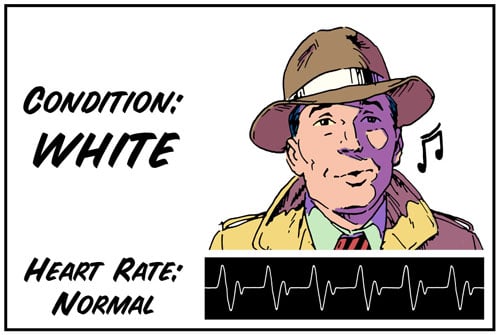
When you’re in Condition White, you’re completely unaware and un-alert to your surroundings. If a threat were to appear, you’d be caught off-guard and wouldn’t be able to respond adequately. Visual and cognitive reaction times are much slower in Condition White and we’re much more susceptible to Normalcy Bias. Because most people are sheep and not sheepdogs, Condition White is the norm in society. Ideally, the only time you should be in Condition White is when you’re secure in your home or asleep. When you leave the house, you should leave Condition White.
Condition Yellow
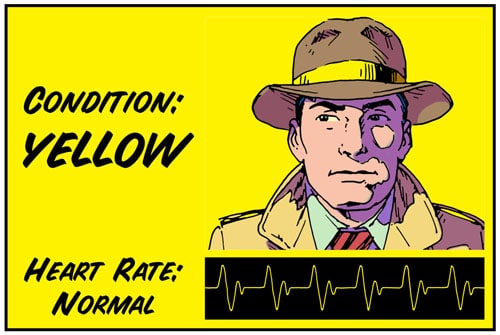
Condition Yellow is best described as relaxed alert. There’s no specific threat situation, but you have your head up and eyes open, and you’re taking in your surroundings in a relaxed, but alert manner. When you’re in Condition Yellow, you’re less likely to be caught off-guard from a sudden threat and you are better able to respond should a threat arise. Heart rate is normal, so there isn’t any degradation of fine motor skills or cognitive ability.
Tactical experts recommend that warriors stay in Condition Yellow at all times. In fact, many Air Force pilots stick a yellow dot on their watch or in the cockpit to remind them to stay in Condition Yellow.
Condition Orange
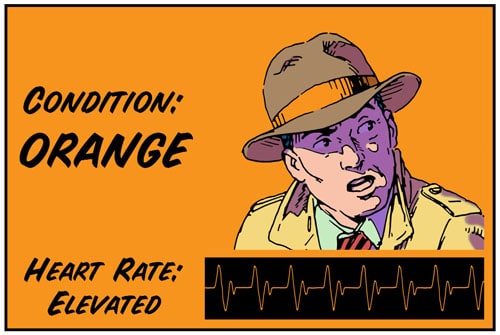
You enter Condition Orange when you identify a possible, specific threat. Something isn’t quite right and has your attention. Your goal isn’t to take action while in Condition Orange. Rather, it is to become extra vigilant so you can determine if a possible danger is in fact a threat that needs a response. Maybe you smell smoke, or perhaps you identify a person in the water who may be drowning, or maybe the guy walking towards you in a dark side-street is acting funny. In all of those situations, you’d want to be in Condition Orange.
While in Condition Orange, you should be formulating an attack plan on what you’ll do if you verify the threat, e.g., “If there’s a fire, I’ll call 911,” or ”If he’s drowning, I’ll jump in and rescue him,” or “If he pulls out a gun, I’ll pull mine and shoot.”
When you’re in Condition Orange, stress levels will increase, as will your heart rate. However, you shouldn’t experience any cognitive or motor deterioration.
Staying in Condition Orange’s increased vigilance level on a regular basis isn’t recommended as it can be mentally and physically taxing. If you verify that a possible threat isn’t a threat, you should immediately drop back down into Condition Yellow’s relaxed alert. However, if you confirm that something or someone is indeed a threat, you should immediately move to…
Condition Red

You’ve verified the threat — now it’s time to implement the action plan you developed while in Condition Orange. When you’re in Condition Red, your mind and body are primed for action. Adrenaline is pumping through your veins and your heart rate is up to between 115 and 145 beats per minute. Studies have shown this to be the optimal level for tactical and survival scenarios. Complex motor skills, visual reaction times, and cognitive reaction times are at their peak.
While complex motor skills and visual and cognitive reaction times are at their best in Condition Red, fine motor skills, like writing or threading flex cuffs, deteriorate.
Condition Gray

Condition Gray wasn’t part of Cooper’s original color system, but after analyzing years of research, Grossman and his colleagues added it. When you reach Condition Gray, your heart rate rises above the optimal range of 115-145 BPM and goes up to 145-175 BPM. Consequently, mental and physical performance begins to suffer dramatically and puts the fighter at risk of being injured or killed.
Tunnel vision and loss of depth perception is common, which means a fighter may miss additional threats in the vicinity. Tunnel vision also often causes fighters to “not see” innocent third-party bystanders in a fight. This phenomenon is a big reason why most firearms trainers these days instruct students to get in the habit of scanning their environment after they neutralize a threat. The simple act of looking side-to-side can help disrupt tunnel vision.
Auditory exclusion is another common symptom of Condition Gray. Fighters who’ve experienced auditory exclusion report not hearing their partner’s gun fire, even though the gun was going off right next to him. However, they’ll often remember hearing shouts from their partner.
Complex motor skills, like gun manipulation or non-armed combatives, begin to suffer in Condition Gray. Gross motor skills, like running, jumping, pulling, and pushing are still at optimal levels.
One possible and positive symptom you may experience in Condition Gray is “bullet time”– a mental phenomenon in which everything around you appears to be moving in slow motion, a la The Matrix. Bullet time can give a fighter more clarity and help him react. In his study on deadly force encounters, Dr. Alexis Artwohl surveyed police offers who had experienced deadly force encounters and found that nearly 62% of them experienced slow-motion time.
It’s called “Condition Gray” because Grossman believes more research needs to be done on arousal levels where the heart reaches 145-175 BPM. Grossman notes in his book On Combat that while most untrained men will begin to experience the mental and physical deterioration outlined above, some fighters are still able to perform at optimal levels in Condition Gray. Research indicates that with proper training and stress inoculation, fighters can properly and safely “push the envelope” of Condition Red into the elevated heart rates of Condition Gray.
Condition Black
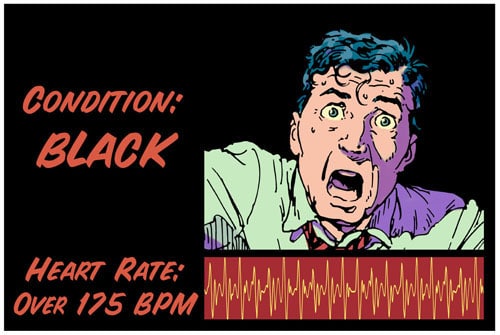
Condition Black wasn’t part of Cooper’s original system either, but was added by the U.S. Marine Corps. When you reach Condition Black, your heart is beating faster than 175 BPM. At this level of arousal, a fighter — even a well-trained one — experiences catastrophic breakdown of mental and physical performance.
In addition to tunnel vision, auditory exclusion, and deterioration of complex motor skills, other symptoms are present in Condition Black.
Most fighters will experience bladder and bowel voiding — in other words, they poop and pee their pants. In high-stress, life-or-death situations, sphincter and bladder control just aren’t a priority for your body. Moreover, it wants to get rid of as much waste as it can so you’re in a better position to fight or run. At this point, the decisions your physical body makes are overriding any cognitive ones. Lt. Col. Grossman actually discusses this issue in great detail in On Combat. While many soldiers and fighters won’t admit publicly that they messed themselves, in anonymous surveys conducted after WWII, one-quarter of soldiers admitted they peed themselves during combat and one-eighth admitted to defecating. Grossman believes the number was likely even higher than that.
Extreme vasoconstriction is also typically present in Condition Black. Vasoconstriction is when the blood vessels narrow to constrict blood flow. In life-or-death situations, your body wants most of your blood to stay near vital organs and large muscles that can be used to fight or run. One benefit of this is that if you were to sustain a wound, vasoconstriction helps limit the amount of bleeding you experience. Extreme vasoconstriction causes people to look “white with fear” as all the blood has been shunted away from the skin’s surface to more vital parts of the body. While this is a survival mechanism, it unfortunately leads to deterioration of complex motor skills.
Another physical reaction is that your forebrain (the executive part of your brain) shuts down and your more primitive middle brain takes over. Grossman calls this the “puppy dog” brain. Without executive functioning, you’re susceptible to irrational fighting or fleeing. As an example of this type of irrational behavior, many soldiers fighting in the frontlines of WWI and WWII reported seeing comrades run out from behind protection and into enemy fire without any rhyme or reason. As Grossman puts it, “in Condition Black you can run and you can fight like a big, hairless, clawless bear, but that is about all you are capable of doing.”
In that same study conducted by Dr. Artwohl mentioned above, he found that a very small percentage of police offers experienced freezing, or temporary paralysis during a deadly force encounter. In these cases, the body doesn’t fight or run, it just stops cold, leaving the fighter very vulnerable.
Managing Arousal in High-Stakes Situations
Now that we understand how stress alters our performance, let’s take a look at some of the things that combat researchers have found help mitigate its effects. While you can’t completely control where your heart rate goes in a high-stress situation, learning and practicing certain techniques can help you lower it and maximize your resistance to stress, allowing you to perform at optimal levels for as long as possible.
Practice tactical breathing. Tactical breathing was developed by Lt. Col. Dave Grossman. It’s a technique that soldiers and police officers use to quickly calm down and stay focused during firefights. Here’s how to do it:
- Slowly inhale a deep breath for 4 seconds.
- Hold the breath in for 4 seconds.
- Slowly exhale the breath out for 4 seconds.
- Hold the empty breath for 4 seconds.
- Repeat until your breathing is under control.
Simple. What’s hard is having the discipline to do this when you start feeling stressed out.
Tactical breathing isn’t just useful for deadly force encounters. Use it anytime you’re feeling stressed out and need to bring yourself back down to optimal arousal levels.
Meditate. Studies show that individuals who practice meditation can clear distracting and stressful thoughts (like worry) from their mind more quickly than individuals who don’t meditate. That sort of ability comes in handy in high-stress situations like deadly force encounters.
The U.S. military is actually experimenting with mindfulness meditation training with its new recruits. The hope is that meditation’s stress-reducing benefits will help soldiers stay out of Condition Black while in the heat of combat, as well as help them recover more quickly after the encounter.
There’s not much to meditation. Just sit in a quiet place and focus on your breath going in your nose and out your mouth. Whenever a distracting thought pops up, don’t get flustered. Just name the thought, let it go, and focus back on your breath. If you’re like me, you’ll find that when you first start meditating, you get easily distracted by your thoughts. Don’t get discouraged; with time your mind will quiet down, and your ability to dismiss unwanted thoughts will improve.
Start off with one 10-minute session daily, and slowly increase your sessions to 20 minutes. If you have time, you may consider doing a 20-minute meditation session in the morning and another 20-minute session at night.
Practice visualization. Emerging research shows that warriors who visualize hypothetical high-stress scenarios perform better in actual high-stress situations than those who don’t. For example, officers who take part in visual exercises demonstrate better marksmanship than those who skip this technique.There’s also evidence that visualizing successful management of high-stress situations reduces a combatant’s anxiety and stress response when the events actually occur, thus allowing the fighter to stay in optimal Condition Red longer.
Here are some rough and ready guidelines on performing visualization exercise:
- Make the visualization as vivid as possible. Incorporate all your senses and emotions.
- Visualize problems and sticking points, but — and this is the critical part — always visualize yourself successfully overcoming the problem or obstacle. Never visualize failure.
- Never rely on visualization alone. It’s important to combine it with tactical practice and role playing.
Use task-relevant instructional self-talk. To counter the detrimental performance effects of stress, talk yourself through complex actions as if you were an instructor. For example, many police officers are trained to speak out loud during every step in the gun firing process using the acronym BRASS:
- Breathe
- Relax
- Aim
- Sight
- Squeeze
Another example of task-relevant instructional self-talk would be to yell out “Tap, Rack, and Go!” whenever you encounter a gun jam.
Don’t worry if people think you’re crazy. Research has shown that this sort of self-talk can increase performance on both cognitive and physical tasks.
The key with this type of self-talk is to keep it brief and positive.
Stay active and outwardly focused. In the book War, by Sebastian Junger (which I highly recommend), he shares an interesting study done on a Special Forces team during the Vietnam War. The team was stationed at an isolated base along the Cambodian border and knew there was a good chance of the base being completely overrun by a force of Vietcong. Surprisingly, researchers found that in contrast to the officers, the stress levels of the enlisted men actually dropped before an expected attack, and rose when the attack failed to materialize. Researchers offered this explanation: “The members of this Special Forces team…were action-oriented individuals who characteristically spent little time in introspection. Their response to any environmental threat was to engage in a furor of activity which rapidly dissipated the developing tension.” This activity included laying C-wire and mines around the base, which as Junger notes, “was something they knew how to do and were good at, and the very act of doing it calmed their nerves.”
When you’re facing a threat you can anticipate in advance, take a cue from the men of the Special Forces; instead of sitting around navel-gazing, bouncing your leg up and down, and getting your heart rate up before anything even happens, keep yourself occupied with preparations – check your equipment, mentally rehearse your mission, etc.
Stress Inoculation Through Realistic Training
Remember the old saying amongst soldiers: “You do not rise to the occasion in combat, you sink to the level of training.”
Thus, the best way to overcome the detrimental effects of stress on performance is to inoculate yourself from it altogether through consistent, realistic training.
From a self-defense standpoint, this means you need to do more than just go to the gun range to practice your marksmanship or punch the heavy bag in your garage. You’ll actually need to train your techniques under the same sort of pressure you’d experience in a real-life situation. For handgun training, this could be achieved with simunitions or airsoft guns; with hand-to-hand self-defense, live sparring can give you similar stress levels as a real-life fight.
With proper, consistent, and realistic training, you can hone your body to perform at optimal levels, even when the going gets the toughest.
____________________
Sources:
Sharpening the Warrior’s Edge by Bruce K. Siddle
On Combat by Dave Grossman and Loren W. Christensen
Warrior Mindset by Dr. Michael Asken, Loren W. Christensen, Dave Grossman and Human Factor Research
Illustrations by Ted Slampyak
Related posts:
- Testosterone Week: The Benefits of Optimal Testosterone
- Heading Out on Your Own — Day 30: How to Manage Stress
- The Warrior’s Guide to True Manliness
- Are You a Sheep or Sheepdog? Part III: Your Roadmap to Becoming a Sheepdog
- Be Clutch, Don’t Choke: How to Thrive in High Pressure Situations (Part II)
Things All Scouts Should Know: 16 Camping and Life Hacks from 1911

Editor’s note: In 1911, the first edition of Boys’ Life magazine was published. The first several issues included a short-lived section called “Things All Scouts Should Know,” which featured short, practical tips for boys at home and out camping. Below is a collection of my favorites; some are actually practical and handy, others just fun and interesting, and all are enjoyable to read.

TAKE A SEAT

If you ever find yourself in the unfortunate predicament of the Irishman who was “hanging between nothing and space” with only a rope to hold on to, you should be able to form quite a comfortable little seat if you hold the rope as depicted in this sketch.
All you have to do is to hang on for a moment or two with your left hand, catch the end of the rope with the right, and bring it up under you in the form of a loop. Then grip both the end and the rope itself together, and you will find yourself sitting in the loop, and easily able to support your own weight.
HANDY TWEEZERS

Tweezers are a thing one rarely sees about, and they are always not in evidence when required; that is, when one is unfortunate enough to run a splinter into one’s hand.
When scouting, one is always liable to get thorns and splinters into the flesh, and if one carries a pen-nib on one’s person it will be found the best of tweezers. In the illustration, a hand in which a splinter has entered is shown, and this is the method by which it is ejected.
Press the nib firmly at B, just in front of the splinter, when it will open. See that the splinter is between the two divisions, then press the nib along each side of the splinter and let it close up. The splinter will come out without any trouble.
PREVENT SLIPPING

You may have occasion at one time or another to hoist some heavy article from one place to another.
If you are doing this by means of a hook, you should know the correct way of roping the article on to the hook.
A “Blackwell Hitch” should be used, and this is simply and quickly made by looping the rope over the hook, as it is not nearly so likely to slip.
TO CLEAN PLATES

Greasy plates are hard to clean without hot water, and when out scouting, or in camp, boiling water is not always easy to obtain. A tuft of grass with damp earth adhering to it is a good substitute. Rub the earth well over the plate, and it will soon remove the grease. Then rinse the plate in cold water, and it will be perfectly clean.
Failing sand, earth will also clean grease or oil out of bottles.
A BOTTLE BEACON
![]()
An uncovered signal light displayed on the top of a hill is, of course, in the very finest position for being blown out by the wind.
On the other hand, when you want to make use of such a light, a glass-protected lantern is not always at hand.
But a candle, or a piece of one, and an empty bottle are generally to be obtained, and with those you can get along very famously if you know how, even on the very gustiest of nights.
Break off the bottom of the glass bottle, which should be without a cork. Plant the candle in the ground, light it, and quickly pop the bottle over it, pressing the latter down firmly into the earth.
There you have a cheery little beacon, that will shine out and not blow out, no matter how the gale rages.
OPENING A NEW BOOK

Many people soil the binding of new books by carelessly opening them. The proper way to open a volume when it is new is to place it with its back on the table and then to let both the board covers gently down while holding the leaves in one hand. Then open a few leaves at the front, then a few at the back, until the center is reached.
By going slowly like this the first two or three times the book is opened, you will make it last much longer than you would by opening it in a great hurry.
A CAMP NIGHT-LIGHT

The simple contrivance that is known as the camp night-light, is one that often proves handy for camping out. It is formed of a small tin without a lid, and half-filled with fine earth.
Upon this are melted any odd ends of candle, until a fair thickness of tallow has been obtained. A thin, dry stick neatly wrapped round with a piece of say, calico, is then pushed down through the tallow and earth, right down to the bottom of the tin. When this wick is lighted, the camp night-light sheds a modest but useful glow all around.
And, of course, there is no oil to get dangerously upset or spilling about, to spoil things.
THE GLASS WILL NOT CRACK
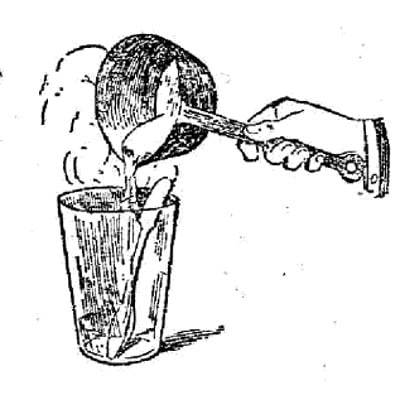
When hot water is poured into a glass, the latter is very likely to crack if precautions are not taken. To prevent the glass from breaking, you should place a spoon in it and let the hot liquid run down the metal, as shown in the illustration.
This will take the heat away from the glass, and so enable you to keep your store of glass intact.
HELPS WITH BOILING EGGS

Every Scout is on terms of great familiarity with the egg. Camp life without it would not seem like camp life, for does not the egg fill one of the most important roles in the menu? Boiled in a few minutes it is a handy thing when there is a rush on, and it can be made the backbone of many a tasty dish. No wonder that it is an autocrat of the camp.
But, boiled in a billy-can it can give the boiler something to think about. It’s a very easy thing to drop an egg into a billy-can full of water, but it’s not such an easy matter to get it out. A spoon of no mean size is required to manipulate the egg.
To save time and trouble in boiling an egg, a Scout, having experienced the above difficulties, has constructed the egg-holder shown in the diagram. It is made of wire, spiral-shaped at one end to contain the egg, and with a hook at the other to fasten on the side of the can. In this way the egg is held fast while boiling so that it can be easily removed from the billy when it is done by lifting the hook.
HIDDEN IN SOAP

Some people when they wish to hide anything go to a great deal of trouble. The chimney is now too well known for absolute security, so digging in the ground in the coal cellar or some such place is resorted to.
There is not the slightest reason to make such a fuss, for the best place to hide anything is in an object which does not seem to offer any scope as a hiding place.
Soldiers seem to have realized this, and it is said that when “Tommy Atkins” received his money he used to make a hole in a bar of soap, place the coins in the middle, as shown in the illustration, and seal up the end by banging the bar down on something hard. Who would think of looking for anything in such a place?
Tobacco has been smuggled into this country in imported broom handles and lady smugglers used to cross the Atlantic with babies who were never known to cry. The reason was made apparent when it was discovered that the babies consisted of lace and other contraband articles.
So when you want to hide something give a simple hiding place a preference.
TO STAND THE STRAIN
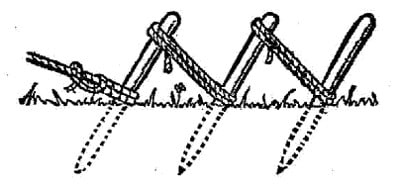
For fastening a rope upon which strain is to be placed, a picket, or sharp stake, like a big tent-peg, is commonly used. But, if the strain is great, or if the only pickets you have handy happen to be small, it may be necessary to make a holdfast for the purpose.
This is constructed of three pickets, driven into the ground at a slope, one directly behind the other, and the top of each one lashed to the lower part of the picket behind it, as shown.
Such a holdfast should be neatly put together, and it will then withstand a tremendous strain on the rope.
FRESH OR STALE?

Here is something more about the egg, much more important than the boiling question. It is to see whether it is worth boiling or not. No one but a person unpossessed of the sense of smell can mistake a bad egg when it is opened, and the most unfortunate individual is he who has opened it and perhaps carried the first spoonful in the direction of the nose.
The difference between a fresh and a stale egg can be detected, however, the moment they are put in the water for boiling the fresh egg immediately sinks to the bottom and lays flat upon its side, whereas, the stale egg will be seen to rise on end. If it rises slightly it may only be a trifle stale, but according to the angle at which it inclines with the bottom of the saucepan, its staleness can be told. If it rises to the top, as shown in the illustration — well, take it out to the dust bin, but be careful not to break it. One disadvantage to our camp boiling receptacle, described above, is that it prevents the testing of the egg in its boiling water, and in this case it is advisable to test the egg in a fairly shallow vessel beforehand, or with cold water in the billy-can.
FLATTENING NAIL POINTS

There is a right and a wrong way of doing everything, even to the flattening of a projecting nail.
The usual way this is done is shown in Fig. 1, and, although it may be flattened down a little more than is shown in the illustration, the method is wrong and the point is always liable to catch in everything it comes into contact with.
The proper way to flatten the nail down is to place some thin circular object, such as a piece of wire (A), under the projection when hammering down (Fig. 2). This has the effect of turning the point round so that when it is finally hammered flush with the wood (Fig. 3), the point will be driven in, instead of being dangerously turned out.
ONE WAY OF DINING IN CAMP

Provided the soil is dry and not loose or uneven, a very good mess table for use in camp can be made as follows:
Dig a fair sized oval trench about two feet deep, leaving an oblong space in the center, which forms the table, and then sit round on the ground, with your legs in the trench, and your plates of food in front of you, as shown in the illustration.
DO IT NEATLY
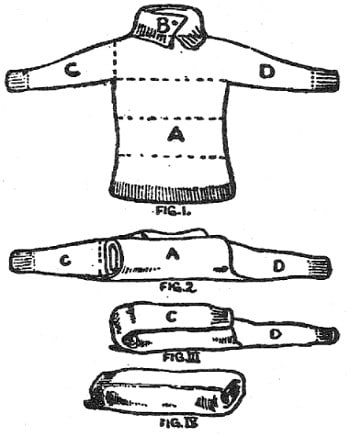
Many Scouts, no doubt, find it difficult to keep a jersey, or sweater, neatly and securely rolled. Here is a method which will overcome this difficulty, and make it quite easy to strap the jersey on to the belt.
First lay it out flat, as in Fig. 1, folding over the collar B, at the neck. Then fold over the body, A, three times, as shown by the dotted lines.
The jersey should then assume the appearance of Fig. 2.
Next turn the sleeve, C, over the body, A, as in Fig. 3, and then pull the arm, D, over the body and other sleeve, turning it inside out for that purpose, after the fashion in which you roll a pair of stockings together.
The result, as shown in Fig. 4, is a neat oval roll, which can be easily and comfortably strapped on to your belt.
AN EASY CURE
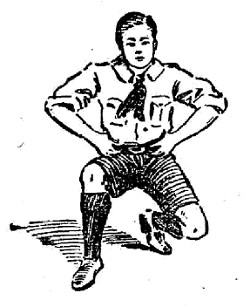
One of the most annoying things that can happen when you are running is to feel that unpleasant pain in the side known as the stitch. The accompanying illustration shows a quick and easy cure for this annoyance.
Bend down in the manner shown, place your hands on your hips, with thumbs to the rear, and then start walking along in this undignified position.
When you have proceeded a few yards, then get up again and you will find that the pain has disappeared.
Do you have any camping/scouting hacks that you learned as a youngster? Share them with us in the comments!
Related posts:
- How to Remove a Fish Hook from Your Finger: An Illustrated Guide
- How to Make a Rope Swing and Fly Like Tarzan: An Illustrated Guide
- The Boy Scouts of America: Then and Now — A Comparison of the 1911 and Modern Handbooks and Merit Badges
- 9 Ways To Start a Fire Without Matches
- Gear Up: A Man’s Guide to Camping
Fatherhood outside St. Mary's and inside Walmart...
(Prince) William says he practiced making sure the car seat fit securely before driving off. "Driving your son and your wife away from hospital was really important to me," he said.
Standing in line at Walmart, I watched a normal Joe ahead of me buying his daughter her school supplies. The man helped his eight-year-old daughter transfer pencils, notebooks, and other stuff I didn't recognize from the cart onto the small 20-items-or-less checkout counter. Halfway through the piling up, the girl looked up at her Dad and demonstrated her budding gift for commanding the male sex: "Dad, let me do it!"
He acted like he hadn't heard and, thankfully, Her Royal Highness didn't protest again. Last on the pile was the annual backpack with this year's graphics and colors. Then, having accomplished her part of the mission, the girl walked a few feet and sat down on a bench from whence she surveyed her domain and awaited her father's duty of paying for her life and happiness. You know, money.
Dad wasn't tall and wore shorts hanging down to his calves. Nothing notable in his looks or clothing, nor in the way he fulfilled the privileges of fatherhood. As he ran his credit card and punched buttons, the cashier smiled and asked if school was starting this week?
He said "yup, Tuesday" and they exchanged conspiratorial looks of knowingness. I thought for a second about getting down on my knees and pleading with this innocent father not to send his precious daughter... to the soul-shredding temples of secularism and God-hatred that are most public schools today, but I didn't have the heart for it.
Instead, my mind wandered afield to thoughts of God's inestimable kindness in giving us daughters. Sons too—but especially daughters. How they soften us up! Whether they're newborn or ten, twenty, or thirty years old, what joy they bring us! Blushes and pimples are equally beautiful and, when we hug them, we nuzzle their sweet-smelling hair and all is well in God's world. So precious to us.
These were my thoughts there in Walmart. In our age of sexual depredations, may I still speak this way without offending the righteous?
Then I thought that this moment in this man's life was just a single act of kindness from God that is reproduced every time a man loves a woman fruitfully and is presented a daughter by His wife through the providence of God Almighty. In a few years that man luxuriates in the glorious privilege of driving her to Walmart to get her school supplies. There is no greater joy in life. Honestly.
Unless it's figuring out how to plug in the car seat, strap in your newborn ever so gently, then turn to hold your child's mother's hand as she climbs onto the passenger seat ever so gingerly for the ride home from St. Mary's Hospital. Again, no greater joy.
With fatherhood, it matters not a bit whether it's the joy of a prince or a fading shrimp of a wannabe jock at Walmart. They're both agreed and the cashier takes joy watching. What grandmother doesn't love every dutiful father? He's joyful. The mother of his newborn child is joyful as she watches his tenderness. The world looks on and even the jaded rejoice. The kingdom is reunited as it watches the prince's joy. And, over here in every last Walmart, the meek and lowly are delighted as they watch the eight-year-old order her father, "Dad, let me do it."
It was inevitable, though, that as the father pushed the cart toward the door and his daughter descended from her throne to join him, my mind turned to Reformed sub-Christians who train their daughters to disdain fruitfulness. Presbyterian churches today have taught their daughters to hate the vulnerability of true wifehood and motherhood. We despise the thought of our daughters wasting their beauty, brilliance, and great importance on marriage, home, and motherhood.
The first rule of Reformed childrearing is "My daughter will never ever be just a housewife and mother. She's made for excellence and I mean to force her to pursue it."
I say "force" because, again and again, young Reformed college freshman, both Christian schooled and home schooled, respond with great joy when we teach them from Scripture that God has commanded us to be fruitful and multiply, and that He desires Christian marriage to propagate a godly seed. "You mean I can aspire to be a housewife and mother?!?! I've never heard that before! You're telling me that's enough? I'm not wasting my life by doing what, in the deepest part of my heart, I've always wanted more than anything else? O happy day!"
There's no doubt in my mind that the young father running his credit card at Walmart as his daughter waits and the cashier smiles at him tenderly is closer to the Kingdom of Heaven than all the Reformed lawyers, professorettes, and engineers who know how to pronounce "sovereign" and eagerly await Crossway's Gospel Transformation Bible while training their daughters to pursue that bitch goddess of success we call "excellence."
I love vulnerable mothers who are dependent on their husbands. I love daughters whose mothers have taught them to boss their fathers around. I love school supplies. I love pregnancy and birth and babies. And in each of these, I'm in lockstep with every prior generation of God's Covenant People.
Who gives a you-know-what about excellence and brilliance when a newborn baby—yea, a newborn baby daughter—is the alternative.
Here's to you, Michal and Heidi and Heather and Hannah and Emily and Amanda and Dawn and Nicole and Anna and Becky and Joyce and Laura and...
My precious Mary Lee.
Offering H.E.L.P. in Times of Suffering
Doug Wolter, a pastor in Humboldt, Iowa, who is leading his church through a tragedy in their town after two high school graduates were killed in a car accident. Sometimes aacronyms can be helpful as prompts for us to remember basic truths that can be easy to forget. Here is what Doug offers:
H – Hope, not answers. When people are in the midst of suffering, they need hope more than answers. Hope is not found in solving the problem, but running to a person: Jesus. We may not know why everything happens, but we can hope in the person who understands suffering more than anyone and sympathizes with us in it.
E – Enter into their pain; empathize with them. Did you know that grieving with someone can be the single most helpful expression of love and care? Weep with them. Just be there for them and be with them.
L – Listen to them and love them in tangible ways. Seek to understand their situation. James 1:19 says, “Be quick to listen and slow to speak.” If you must speak, tell them, “I am standing with you. I am grieving with you.” And love them in tangible ways. Make a meal. Offer a small gift. Spend time with them.
P – Pray for them and patiently walk with them through the long journey of suffering. In the deepest of suffering, some may find it hard to even pray. We can intercede for them and carry this burden. And oftentimes, after the initial help has arrived, we forget the one who is suffering over time. But this is when the church is even more needed. To patiently walk with them and be with them through the long road of suffering.
How to Follow Up After Meeting Someone in Person

Editor’s Note: This a guest post by John Corcoran.
Last year, AoM published a thorough guide on How to Network Effectively, written by Antonio. As he always does, Antonio crafted the definitive resource for how to prepare for and execute a night of networking and socializing.
But even if you already love networking and have enough personal style, charisma, and wit to put Ryan Gosling to shame, you might struggle with what comes next: the follow-up. What happens after you attend a networking or social mixer can make the difference between a productive evening and a complete waste of time.
Many men have trouble following through on and nurturing relationships established at these types of networking events. It’s not easy to approach people who you might have spoken with for only a few minutes before exchanging business cards and moving on. Even though it might be convenient to blame the networker, the problem is usually not with the person. The problem is the system, or lack thereof.
The Importance of Having a Follow-Up System
Although most people understand the important role networking and socializing can play in a career or a business, very few people put in place a methodic system for following up with the people they meet during an evening of networking and socializing. In fact, many just drop the ball entirely and never follow up at all.
Michael Port, a bestselling author and business coach, says having a strategy for keeping in touch with contacts you meet “may be the most important marketing strategy you’ll ever use.” In Book Yourself Solid, Port suggests taking the time to create a system for keeping in touch. “If you don’t have a systematized and automated Keep in Touch Strategy in place, you may, as the old saying goes, leave a lot of business on the table.”
Those who hate networking the most are usually the worst at following up. If you get sweaty palms just thinking about entering a room full of people you don’t know, I’ll bet you are the type who neglects the follow through entirely. That’s actually the worst thing you can do. Not following up just means you’ll have to haul yourself back out on the cocktail circuit again and again and again.
The solution is also not more networking. Spending more time networking without a follow-up system in place is like bailing water from a leaking ship — it will keep you afloat in the short term, but eventually your ship will sink. A better choice is to implement a better system.
Your business or career may even depend on it. Port argues that many businesses have failed simply because they didn’t have a strategy for checking in and keeping in touch with contacts and clients.
Approach Follow-Ups with a Philosophy of Service
When Keith Ferrazzi was growing up, he caddied at a local country club in the wealthy town next door to his own. During those long outings, he had ample time to observe how successful and wealthy members of the country club treated one another. “They found one another jobs, they invested time and money in one another’s ideas, and they made sure their kids got help getting into the best schools, got the right internships and ultimately got the best jobs,” says Ferrazzi. In other words, Ferrazzi saw that the very successful were invested in a spirit of service to one another.
In Never Eat Alone, Ferrazzi writes that the country club provided him “with a simple but profound lesson about the power of generosity. When you help others, they often help you.”
If you struggle with following up, the best approach is to think of your follow-ups with a spirit of generosity. Your goal is not to follow up with people you met because you want to get something from them; you are following up so you can help them, just like the successful members of the country club helped one another.
In the rest of this article, I’ll lay out a system for following up and maintaining contact with people you meet at networking and social events. I have broken down the system into three phases:
- Phase 1 - what steps you should take immediately following a networking event.
- Phase 2 - how you should continue to maintain contact on a regular interval (i.e. every 30 or 60 days).
- Phase 3 - how you should deepen the relationship over the long-term.
Immediate Follow-Up
Let’s assume you just attended a social or networking event, and you met a number of men and women. You can see some potential business or career value to keeping in touch with the people you met. In other words, it wasn’t a Burning Man meetup and you didn’t just get back from Comic-Con, but you actually see business value to further developing these relationships.
Here’s what you should do immediately:
1. Take Notes About The People You Met
Immediately after an event, I will jot down a few quick notes about the people I met. Usually I will write these notes directly on the back of the business cards I collected. It’s important to do this that evening or the next morning while the conversations are still fresh in your mind.
I like writing down any personal details I learned about the person, such as his spouse’s name and his childrens’ names and ages if he has any, and any likes or dislikes or hobbies, such as favorite foods. You never know when this information may come in handy in the future.

2. Send Memorable First Emails Within 24 Hours
The second step is to send memorable follow-up emails. For this first email, you want to demonstrate that you are thoughtful, reliable, and consistent. Just as you will have put in effort to make a good impression at the event itself, you should also make a good impression in your first email. That means you should make sure there are no typos or spelling errors, run-on sentences, clumsy hit-ons, or off-color jokes.
Even though email can be a more casual form of communication, that does not mean it is acceptable for your email to sound like it came from a tween sending texts from the mall food court.
Here’s what your first email should not look like:
Hi Mike:
It was great meeting you, hopefully we’ll run into one another again. Keep in touch. I LOL’d all night – your so funny!
–Joe
A better approach is to follow up on a topic you discussed when you met. Here is a better first email:
Hey Mike: It was great meeting with you, and talking about your burger business’s dilemma with re-branding itself.
I’ve thought more about it, and I think Avalanche Burgers would be a good new name. I saw a statistic recently that 50% of consumers prefer to purchase from a business with a sense of humor, and the fact that your burger joint is attached to a ski resort suggests you have a sense of humor about the threat of avalanches. I also asked my wife what she thought and she says Avalanche Burgers sounds “very cute.”
I have a cousin who works for a branding firm in Chicago. I’m happy to ask him for his input as well. Just let me know.
Good luck as you weigh your decision.
– Joe
You can see how much more memorable that email is. Here’s why this follow-up works:
- Sharing Useful Data. Joe isn’t just pontificating like a know-it-all; he actually shared the useful statistic that 50% of consumers prefer to purchase from a business with a sense of humor, and this piece of information could be very valuable to someone seeking ideas for re-branding their business.
- Surveying Others. Not only did Joe provide Mike with his opinion, but the fact that he asked his wife for her opinion demonstrated he put in extra effort to help Mike out.
- Offering Further Help. By offering to reach out to his cousin, Joe is offering something of even greater potential value to Mike.
- Focusing on the Recipient. Notice Joe did not ask Mike for anything at all.
This second email would take just a little more time than the first, and yet it demonstrates how useful Joe would be as a member of Mike’s extended network. Joe wants Mike to think, “Now this is the kind of guy I want to get to know better.”
3. Send a Handwritten Note
If you really want to make a great impression, send a handwritten note on nice stationery. I received a handwritten note as a thank you from someone I had met recently and I can say it made a big impression on me. I would still send an email anyways, however, so that you demonstrate immediate follow-through, and so it’s easy to connect via email again in the future.

4. Connect on Social Media
The next step is to connect with the person on LinkedIn. Once I am connected with someone on LinkedIn, I know I am less likely to lose touch with them and they will be reminded of me every time I post something to LinkedIn. It’s a great tool for remaining “top of mind” with people in your extended network.
I have a simple, free browser extension called Rapportive installed in my browser so when I start to compose an email in my Gmail account to a person, I see a snapshot of that person’s social media profiles on the right side of my “compose” window.
This great tool allows me to learn a little more about the person, and I can quickly connect on LinkedIn or other social media services in one click.
Monthly Follow-Ups
After the initial follow-up, it’s very easy to lose contact. So the next step is to create a practice of following up on a regular interval, i.e. every 30 days or every 90 days, or even every six months. You can decide whatever interval is comfortable, but be sure to stick to it. The point is to make sure you don’t let so much time go by that the relationship goes cold.
Add Follow-Up Reminders
The next step is to make sure you follow up with that person. This is one of the hardest parts of the follow-up process to manage.
You can go cheap on this strategy by trying to remember to follow up, although chances are contacts will fall through the cracks. Another option is to add reminders in your calendar, but that can be very labor intensive.
I recently started experimenting with an online service that allows me to categorize people based on how frequently I want to follow up with them, i.e. every 30 days, every 60 days, every 6 months, etc. While it isn’t totally necessary to use such a service, you may find as I have that the benefit outweighs the cost. There are plenty of other customer relationship management (CRM) services that you can use.
The most important thing, whether you use a paid service or not, is to make sure relationships don’t go stale. Make sure 6 or 12 months don’t go by without you checking in with people who are important to your business or career. They will forget about you.
How to Follow Up & Add Value
One of the hardest parts about following up with people who you still don’t know all that well is finding excuses for contacting that person without sounding like you are a used car salesman.
A few weeks ago, I got a voicemail completely out of the blue from a business broker I had met a year earlier. In his voicemail, he actually said he was calling to see if I had “any business for him” in the form of clients of mine who might want to sell their business. I felt used, like he had no interest in me at all, only in what I could provide for him. There are a number of excuses he could have used for calling out of the blue, but calling to ask if I had any business for him was not a good approach. Needless to say, I didn’t return the call.
Here are a few ways you can follow up without sounding like you’re only in it for you:
1. Send An Informative Article, a Blog Post, or a Book
One of the easiest and most effective excuses for contacting a person is because you want to share an article, blog post, or book that you think might be valuable to that person. This piece of content could relate to their business or profession, or it could easily relate to a passion, hobby, or family member.
For example, if I know a person’s daughter is about to start a new job after graduating from college, I might send that person an article I read on how to ace your first day and week at a new job. Oftentimes, demonstrating your thoughtfulness as to that person’s beloved family members is a way of forming a stronger personal bond with them.
2. Make an Introduction
Another strategy I love to use, especially with people I just met, is to introduce the new person to someone else I know. People love relevant introductions, especially when the introduction can help them in their business or career. What’s more, if the two people really hit it off, they will always remember you were the person who introduced them.
Here’s an example:
Hey Jim:
I’m cc’ing by way of introduction Phil Mitchell, who I met last night at a Chamber of Commerce mixer. Phil is a business coach in San Francisco focusing on software startups. It turns out Phil is also a huge Cubs fan so you two have something in common.
Phil: Jim lives down the street from me, and our sons are in preschool together. Jim is the founder of a startup called Pets.com that I think is going to be the biggest thing since sliced bread. I thought you two would get along so that’s why I’m making the introduction.
Best,
John
NOTE to self: I should definitely never be a venture capitalist.
3. Invite the Person to a Free or Comped Event
Free or comped events are a great excuse for getting back in touch later. For example, I got an email recently from a woman I know, inviting me to a small panel discussion she thought would be of interest. She was a board member for the sponsoring organization, so she offered me a complimentary ticket.
The key here is the event has to be (A) free or paid for, and (B) relevant or useful to the person you just met. If you try to get the person you just met to buy a ticket to some event you are promoting, you will probably only annoy that person.
4. Mention the Person in your Writing
Another great way to make an impression is by mentioning the person you met, or their company, in a blog post or a YouTube video. For example, Antonio included a photograph of him and Tom Julian, one of his favorite men’s style authors, in his How to Network Effectively post. This is a perfect example of how to create an excuse for further contact. As an author, I’m sure Mr. Julian was grateful to Antonio for mentioning him on such a wildly popular and high-traffic blog.
How to Deepen your Relationships Over the Long-Term
The final step is to deepen your relationships over the long-term. Your goal should be to move the people you meet up the ladder to deeper and more meaningful relationships.
Before you start deepening relationships, you should first ask yourself some tough questions about with whom you want to further relationships.
Determine Which People for Deeper Relationships
Even though you should approach networking with a philosophy of helping others first, you still want those who you help to be in a position to one day repay the favor.
I recommend writing out an actual list of 50+ people who you most want to get to know better over the next 12 months. Having to sit down and create this list may even help create greater clarity as to your business and career goals. The list may include everyone from celebrities to CEOs to colleagues and current or past clients or customers. Every once in a while, you should revisit this list and decide if there are any people who should be added or removed.
Choose What In-Person Events to Use
Once you’ve determined who you want to deepen relationships with, you should start reaching out to meet for lunch, coffee, or a drink. This is a great way to get to know the person better than you probably did in your initial meeting.
There are an infinite number of different types of in-person events you could engage in — lunches, coffees, drinks, dinners, sporting events — but you should choose carefully. If you don’t naturally like networking, then be sure you don’t put yourself in a situation that will make it more uncomfortable. If you’re not athletic, don’t get roped into a golf game. If you hate drinking, don’t meet someone for a happy hour at a bar. If you are great at one-on-one meetings, then perhaps a quiet lunch at an out-of-the-way cafe would be best. Play to your strengths.
Which industry you are in is also going to make a difference as to what events are appropriate. Here are a few ideas:
- Athletic Outings - in some industries, it may be popular to network over a round of golf. In others, it may be popular to play pickup basketball.
- Entertainment Outings - professional ballgames, musical performances, and plays can be a nice way to get to know someone in a relaxed atmosphere.
- Meals, Drinks, or Coffee - if you don’t have a lot of money, this can be a great way to network. Most people have to get lunch or coffee each day anyways, so you might as well turn these activities into networking opportunities by inviting someone to join you.
- Shared Interest Events - from attending religious services to a joint outing at the shooting range, if you have a shared interest, that’s a great opportunity to bond.
- Skype or Phone Calls - if the person lives far from you, then you can always connect via Skype or over a phone call to get to know each other better.
Bring a Small Gift
For bonus points, bring a small gift to give to your recipient when you meet. A gift, however small, can make a huge impression. When Michael Fishman, a marketing advisor and consultant, set up an initial lunch meeting with Ramit Sethi, the popular blogger and bestselling author of I Will Teach You To Be Rich, he brought along an obscure, out-of-print book as a gift. Breakthrough Advertising by Eugene Schwartz sells for around $100 on eBay – a fact which Sethi didn’t know at the time.
Sethi was so impressed by the gesture that when Fishman later asked Sethi to speak at a conference Fishman was organizing, Sethi agreed to waive his standard $20,000 fee.
When you offset the price of the book, that one small gift saved Fishman $19,900. Not too bad for a used book.
Send Thank You Emails After Your Meeting
After you’ve met, send a follow-up email or note thanking the person for meeting with you, no matter who you met. Whether the person is CEO of a Fortune 500 company or unemployed, they gave up their time to meet with you, and thanking them aligns with the spirit of service we are seeking to achieve.
Constantly Re-evaluate Your Approach
The final thought I want to leave you with is to constantly think about how you can improve your follow-up system. Your system should be fluid, just like relationships are fluid. Most of all, proceed with a positive attitude and spirit of helping others, and you should have no trouble developing deeper and more meaningful relationships.
What are your tips for following up after you meet someone new at a networking event? Share them with us in the comments!
_________________________________________
John Corcoran is an attorney, former Clinton White House Writer, and blogger at SmartBusinessRevolution.com, where he writes about how to use political strategies and tactics in business. You can download his free ebook, “10 Ways to Use Secret Political Strategies and Tactics to Grow Your Business.”
Related posts:
- How to Remember a Person’s Name (And What to Do When You Can’t)
- How to Follow the Art of Manliness
- Heading Out on Your Own: Day 13 — Know How to Network
- How to Make Introductions Like a Gentleman
- How to Run a Meeting
She was the music heard faintly at the edge of sound

Detective novelist Raymond Chandler's wife of 30 years, Cissy, died on December 12th, 1954 after a long and painful battle with pulmonary fibrosis during which the author wrote The Long Goodbye. As can be seen in the following touching and affectionate letter, written to friend Leonard Russell shortly after Cissy's passing, Raymond was deeply affected by the loss of his wife, and it seems he never really recovered. Sadly, he died five years later a broken man, having attempted suicide and returned to the alcoholism she had previously helped him to avoid.
(Source: Selected Letters of Raymond Chandler; Image: One of the very few photos of Raymond and Cissy together, via.)
December 29, 1954
Dear Leonard:
Your letter of December 15th has just reached me, the mails being what they are around Christmas time. I have received much sympathy and kindness and many letters, but yours is somehow unique in that it speaks of the beauty that is lost rather than condoling with the comparatively useless life that continues on. She was everything you say, and more. She was the beat of my heart for thirty years. She was the music heard faintly at the edge of sound. It was my great and now useless regret that I never wrote anything really worth her attention, no book that I could dedicate to her. I planned it. I thought of it, but I never wrote it. Perhaps I couldn't have written it.
She died hard. Her body fought a hundred lost battles, any one of which would have been enough to finish most of us. Twice I brought her home from the hospital because she hated hospitals, and had her in her own room with nurses around the clock. But she had to go back. And I suppose she never quite forgave me for that. But when at the end I closed her eyes she looked very young. Perhaps by now she realizes that I tried, and that I regarded the sacrifice of several years of a rather insignificant literary career as a small price to pay, if I could make her smile a few times more.
No doubt you realize that this was no sudden thing, that it had been going on for a long time, and that I have said goodbye to my Cissy in the middle of the night in the dark cold hours many, many times. She admired and liked you very much. I'm not sure that she liked Dilys as much as I did, because possibly she suspected that I liked her too much. And it is just possible that I thought she liked you a little too much.
I hope that you are both well and prosperous and that I may have the privilege of seeing you again in the not too distant future, with or without the butler from the Ritz. And I hope I am not being too sentimental if I sign myself,
Yours affectionately,
(Signed)
RSS Feed proudly sponsored by TinyLetter, a simple newsletter service for people with something to say.
It's the real thing

In March of 1970, having been shown an advertisement for the newly-published book in the New York Times, Coca-Cola brand manager Ira C. Herbert wrote to Grove Press and asked that they stop using the quote "it's the real thing"—a slogan associated with the soft-drink since the 1940s—when promoting Diary of a Harlem Schoolteacher, Jim Haskins' classic first-hand account of life as an African-American teacher in 1960s Harlem, New York. A few days later, Grove Press's Richard Seaver responded defiantly with a letter that was both hugely entertaining and instantly effective, as it resulted in silence from the beverage behemoth from that point on. The full exchange can be read below.
(Letters very kindly submitted by Robert Wood, Sammamish High School; Image: Richard Seaver (left) at work at Grove Press, via Reality Studio.)
March 25, 1970
Mr. R. W. Seaver
Executive Vice President
Grove Press, Inc.
214 Mercer Street
New York, New York 10012
Dear Mr. Seaver:
Several people have called to our attention your advertisement for Diary of a Harlem Schoolteacher by Jim Haskins, which appeared in the New York Times March 3, 1970. The theme of the ad is "This book is like a weapon...it's the real thing."
Since our company has made use of "It's the Real Thing" to advertise Coca-Cola long prior to the publication of the book, we are writing to ask you to stop using this theme or slogan in connection with the book.
We believe you will agree that it is undesirable for our companies to make simultaneous use of "the real thing" in connection with our respective products. There will always be likelihood of confusion as to the source or sponsorship of the goods, and the use by such prominent companies would dilute the distinctiveness of the trade slogan and diminish its effectiveness and value as an advertising and merchandising tool.
"It's the Real Thing" was first used in advertising for Coca-Cola over twenty-seven years ago to refer to our product. We first used it in print advertising in 1942 and extended it to outdoor advertising, including painted walls—some of which are still displayed throughout the country. The line has appeared in advertising for Coca-Cola during succeeding years. For example, in 1954 we used "There's this about Coke—You Can't Beat the Real Thing" in national advertising. We resumed national use of "It's the Real Thing" in the summer of 1969 and it is our main thrust for 1970.
Please excuse my writing so fully, but I wanted to explain why we feel it necessary to ask you and your associates to use another line to advertise Mr. Haskins' book.
We appreciate your cooperation and your assurance that you will discontinue the use of "It's the real thing."
Sincerely,
Ira C. Herbert
----------------------------
March 31, 1970
Mr. Ira C. Herbert
Coca-Cola USA
P.O. Drawer 1734
Atlanta, Georgia 30301
Dear Mr. Herbert:
Thank you for your letter of March 25th, which has just reached me, doubtless because of the mail strike.
We note with sympathy your feeling that you have a proprietary interest in the phrase "It's the real thing," and I can fully understand that the public might be confused by our use of the expression, and mistake a book by a Harlem schoolteacher for a six-pack of Coca-Cola. Accordingly, we have instructed all our salesmen to notify bookstores that whenever a customer comes in and asks for a copy of Diary of a Harlem Schoolteacher they should request the sales personnel to make sure that what the customer wants is the book, rather than a Coke. This, we think, should protect your interest and in no way harm ours.
We would certainly not want to dilute the distinctiveness of your trade slogan nor diminish its effectiveness as an advertising and merchandising tool, but it did occur to us that since the slogan is so closely identified with your product, those who read our ad may well tend to go out and buy a Coke rather than our book. We have discussed this problem in an executive committee meeting, and by a vote of seven to six decided that, even if this were the case, we would be happy to give Coke the residual benefit of our advertising.
Problems not unsimilar to the ones you raise in your letter have occurred to us in the past. You may recall that we published Games People Play which became one of the biggest nonfiction best-sellers of all time, and spawned conscious imitations (Games Children Play, Games Psychiatrists Play, Games Ministers Play, etc.). I am sure you will agree that this posed a far more direct and deadly threat to both the author and ourselves than our use of "It's the real thing." Further, Games People Play has become part of our language, and one sees it constantly in advertising, as a newspaper headline, etc. The same is true of another book which we published six or seven years ago, One Hundred Dollar Misunderstanding.
Given our strong sentiments concerning the First Amendment, we will defend to the death your right to use "It's the real thing" in any advertising you care to. We would hope you would do the same for us, especially when no one here or in our advertising agency, I am sorry to say, realized that you owned the phrase. We were merely quoting in our ads Peter S. Prescott's review of Diary of a Harlem Schoolteacher in Look which begins "Diary of a Harlem Schoolteacher is the real thing, a short, spare, honest book which will, I suspect, be read a generation hence as a classic..."
With all best wishes,
Sincerely yours,
Richard Seaver
RSS Feed proudly sponsored by TinyLetter, a simple newsletter service for people with something to say.
A book is a sneeze

In September of 1952, a few weeks before the publication of Charlotte's Web—the now-classic tale of a pig, Wilbur, who becomes friends with a heroic spider named Charlotte—its author, E. B. White, was asked to explain why he wrote the book by his editor at Harper & Row, Ursula Nordstrom. On the 29th of that month, White responded with the following typewritten letter and explanation, both of which have been kindly supplied to Letters of Note by HarperCollins.
Transcript follows.
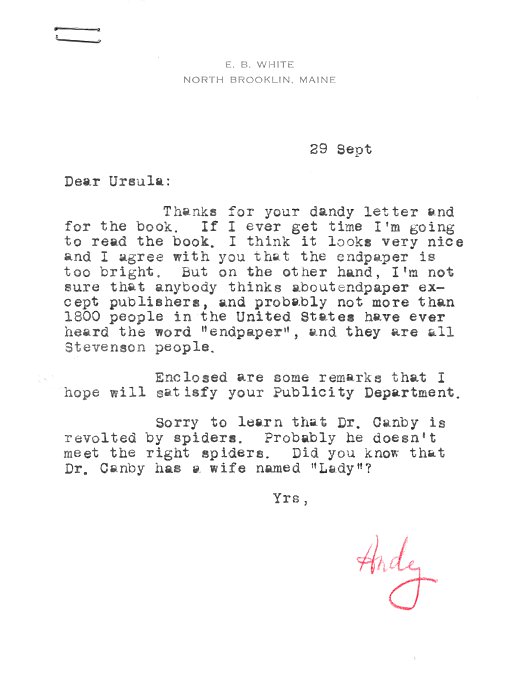

Transcript
E. B. WHITE
NORTH BROOKLIN, MAINE
29 Sept
Dear Ursula:
Thanks for your dandy letter and for the book. If I ever get time I'm going to read the book. I think it looks very nice and I agree with you that the endpaper is too bright. But on the other hand, I'm not sure that anybody thinks about endpaper except publishers, and probably not more than 1800 people in the United States have ever heard the word "endpaper", and they are all Stevenson people.
Enclosed are some remarks that I hope will satisfy your Publicity Department.
Sorry to learn that Dr. Canby is revolted by spiders. Probably doesn't meet the right spiders. Did you know that Dr. Canby has a wife named "Lady"?
Yrs,
Andy
------------------
I have been asked to tell how I came to write "Charlotte's Web." Well, I like animals, and it would be odd if I failed to write about them. Animals are a weakness with me, and when I got a place in the country I was quite sure animals would appear, and they did.
A farm is a peculiar problem for a man who likes animals, because the fate of most livestock is that they are murdered by their benefactors. The creatures may live serenely but they end violently, and the odor of doom hangs about them always. I have kept several pigs, starting them in spring as weanlings and carrying trays to them all through summer and fall. The relationship bothered me. Day by day I became better acquainted with my pig, and he with me, and the fact that the whole adventure pointed toward an eventual piece of double-dealing on my part lent an eerie quality to the thing. I do not like to betray a person or a creature, and I tend to agree with Mr. E.M. Forster that in these times the duty of a man, above all else, is to be reliable. It used to be clear to me, slopping a pig, that as far as the pig was concerned I could not be counted on, and this, as I say, troubled me. Anyway, the theme of "Charlotte's Web" is that a pig shall be saved, and I have an idea that somewhere deep inside me there was a wish to that effect.
As for Charlotte herself, I had never paid much attention to spiders until a few years ago. Once you begin watching spiders, you haven't time for much else---the world is really loaded with them. I do not find them repulsive or revolting, any more than I find anything in nature repulsive or revolting, and I think it is too bad that children are often corrupted by their elders in this hate campaign. Spiders are skilful, amusing and useful. and only in rare instances has anybody ever come to grief because of a spider.
One cold October evening I was lucky enough to see Aranea Cavatica spin her egg sac and deposit her eggs. (I did not know her name at the time, but I admired her, and later Mr. Willis J. Gertsch of the American Museum of Natural History told me her name.) When I saw that she was fixing to become a mother, I got a stepladder and an extension light and had an excellent view of the whole business. A few days later, when it was time to return to New York, not wishing to part with my spider, I took a razor blade, cut the sac adrift from the underside of the shed roof, put spider and sac in a candy box, and carried them to town. I tossed the box on my dresser. Some weeks later I was surprised and pleased to find that Charlotte's daughters were emerging from the air holes in the cover of the box. They strung tiny lines from my comb to my brush, from my brush to my mirror, and from my mirror to my nail scissors. They were very busy and almost invisible, they were so small. We all lived together happily for a couple of weeks, and then somebody whose duty it was to dust my dresser balked, and I broke up the show.
At the present time, three of Charlotte's granddaughters are trapping at the foot of the stairs in my barn cellar, where the morning light, coming through the east window, illuminates their embroidery and makes it seem even more wonderful than it is.
I haven't told why I wrote the book, but I haven't told you why I sneeze, either. A book is a sneeze.
(Signed)
RSS Feed proudly sponsored by TinyLetter, a simple newsletter service for people with something to say.
How Can I Be Sure I’m a Christian?
 In the past, when I have tried to help people wrestle with the theological and existential problem of the assurance of salvation, the outline for Don Whitney’s book, How Can I Be Sure I’m a Christian? What the Bible Says about Assurance of Salvation (NavPress, 1994), has been very useful. Andy Naselli recently posted on this, and I thought it might be helpful if I reprinted it as well.
In the past, when I have tried to help people wrestle with the theological and existential problem of the assurance of salvation, the outline for Don Whitney’s book, How Can I Be Sure I’m a Christian? What the Bible Says about Assurance of Salvation (NavPress, 1994), has been very useful. Andy Naselli recently posted on this, and I thought it might be helpful if I reprinted it as well.
1. Assurance of Salvation—Is It Possible?
It is possible, indeed normal, for the Christian to experience assurance of salvation.
It is possible, indeed normal, for a non-Christian to have a false assurance of salvation.
2. Having Doubts about Your Salvation
It is possible, indeed normal, for Christians to have occasional doubts about their salvation.
Doubting assurance is not unbelief.
The causes of doubt are many:
- Spiritual immaturity may contribute to doubts about assurance.
- Sensitivity to sin may cause confusion about assurance.
- Comparison with other Christians may cloud assurance.
- Childhood conversion affects the assurance of some.
3. The Basis of Assurance
The assurance of salvation rests primarily on
- the character of God
- the works of Jesus Christ
- the truth of God’s promises
4. An Inner Confirmation
Assurance may be experienced partly through the inner confirmation of the Holy Spirit.
How does the Holy Spirit give Christians this assurance?
- He opens our minds to understand the Bible in ways that give us assurance.
- He guides our thinking about the biblical marks of salvation in our lives.
- He brings Scripture and its truths to our minds in various ways that assure us.
- He causes an inner sense of assurance without words.
5. Signs of Eternal Life
Assurance may be experienced partly through the presence of the attitudes and actions the Bible says will accompany salvation [1 John].
- Do you share the intimacies of the Christian life with other believers?
- Do you have a deep awareness of your sin against the word and love of God?
- Do you live in conscious obedience to the word of God?
- Do you despise the world and its ways?
- Do you long for the return of Jesus Christ and to be made like him?
- Do you habitually do what is right more and sin less?
- Do you love other Christians sacrificially and want to be with them?
- Do you discern the presence of the Holy Spirit within you?
- Do you enjoy listening to the doctrines the apostles of Jesus taught?
- Do you believe what the Bible teaches about Jesus Christ?
6. A Spiritual Mind-set
Only those who are spiritually minded are Christians.
You are spiritual minded when you think about the things of God:
- spontaneously and without external causes
- more than anything else
- with more delight and enjoyment than anything else.
You are not spiritually minded if “God is not in all [your] thoughts.”
7. Things That Erode Our Assurance
A true Christian may lose a sense of assurance of salvation because . . .
- he or she refuses to deal with known sin
- of spiritual laziness
- of satanic attacks
- of trials or harsh circumstances
- of illness or temperament
- God seems to withdraw a sense of his presence and blessing.
8. Common Problems with Uncertainty
Those converted as children may experience special difficulties with assurance.
Those who remember little else besides following Christ sometimes have doubts that those with adult or dramatic conversions do not.
Concrete childhood thinking differs from more abstract adult thinking.
An awareness of the Lordship of Christ must expand to cover all the ever-expanding circle of life that comes with maturity.
Stay-at-home mothers of young children may experience special difficulties with assurance.
True assurance won’t lead to spiritual carelessness.
Those worried about the unforgivable sin have not committed it.
9. False Assurance of Salvation
Sources of a false assurance of salvation
- A public commitment or outward response to the gospel
- Baptism
- Involvement with church
- A strong Christian family heritage
- An abundance of good deeds
- An extraordinary experience
- A dramatic personal or lifestyle change
- Material blessing and financial security
- A false understanding of God
- A false understanding of sin and hell
Characteristics of the falsely assured
- They are either unconcerned or angry when warned about false assurance.
- They are either legalistic or loose with spiritual disciplines and duties.
- They are either very weak in or very confident of their Bible knowledge.
- They have either a vicarious Christianity or an overly independent spirit.
- They may be constantly resisting the truth or never able to come to the truth.
10. What to Do If You’re Still Not Sure
Don’t take for granted that you understand the gospel.
Think deeply about the gospel.
Repent of all known sin.
Submit everything to the Lordship of Christ.
Meditate much on 1 John.
Don’t doubt the promises of God.
Believe as best you can and pray for greater faith.
Practice the spiritual disciplines.
If you really love God, take assurance because non-Christians don’t love God passionately.
If you hate your sin, take assurance because non-Christians don’t hate sin deeply.
If you’ve never been baptized, present yourself as a candidate in obedience to Christ.
Don’t neglect the Lord’s Supper.
Don’t compare earthly fathers to your Heavenly Father.
Seek godly counsel if the doubts persist.
Pray for assurance.
Wait patiently upon God to give you a fuller experience of assurance.
Can You Explain How and Why Christ Is One Person with Two Natures?
There are few teachers as clear and helpful as Fred Sanders.
Here is a lecture he gave for laypeople at the 2013 G. Campbell Morgan Theology Conference, sponsored by Biola University’s Torrey Honors Institute:
One of his teaching tools, which combines historical and systematic theology in a chart, is the “Chalcedonian Box”:
Elsewhere he explains:
The metaphor of a box emphasizes the doctrinal boundaries that are recognized by Chalcedon.
On the top, it affirms Nicaea 325 (contra Arianism) by demanding that Christ is God, consubstantial with the Father.
On the bottom, it affirms Constantinople I (contra Apollinarianism) by demanding that Christ is human, consubstantial with us.
The soteriological axioms “God alone can save us” and “what is not assumed is not healed” mark these boundaries out.
As for how the divine and human elements come together, Chalcedon marks out the right and the left with its four mighty negatives: no confusion and no change on the one hand (contra Monophysitism Eutychianism ), but no division and no separation on the other hand (contra Nestorianism).
See also my post, “Thinking through Christology“
Is Jesus God?
I was once at a conference, talking with some colleagues who had a display at a hotel. A Muslim man approached us, demanding that one of us—just one of us—answer just one question, something no one had ever been able to answer for him. “You say that Jesus is God, right?” I answered in the affirmative. “And you say that God is in heaven, right?” I nodded. “And you say there is only one God, not two?” I smiled, knowing where he was going. “Then how is it,” he said, pointing his finger at me, “that God was talking to God?! It makes no sense at all!”
I asked him if I could ask him a question: “Are you a human being?” Yes, he replied. “Am I a human being?” He nodded. “We are both human but we are not the same person. So the Father and the Son share the same nature of God but are distinct persons.” He unleashed a string of expletives and walked away.
Now my reply was not fully adequate, and the analogy has some severe limitations (as Bob Letham explains in his excellent book on The Holy Trinity), but it at least tries to start the conversation with a distinction between nature and person (which I’ve briefly written about here).
So does the New Testament really teach that Jesus is God? The NT often uses “God” (Greek: theos) as synonymous with “God the Father”— and Jesus is not the Father. But the NT also frequently uses “God” as the more generic term for the divine nature. So “God” is not always a reference to the Son in particular, but the Son is always God.
There are several examples where Jesus is explicitly called God. Here are the clearest ones:
John 1:1, “In the beginning was the Word, and the Word was with God, and the Word was God.”
John 1:18, “No one has ever seen God; the only God, who is at the Father’s side, he has made him known.”John 20:28, ”Thomas answered him, ‘My Lord and my God!’”Romans 9:5, ”To them belong the patriarchs, and from their race, according to the flesh, is the Christ who is God over all, blessed forever. Amen.”Titus 2:13, “waiting for our blessed hope, the appearing of the glory of our great God and Savior Jesus Christ”Hebrews 1:8, ”But of the Son he says, ‘Your throne, O God, is forever and ever, the scepter of uprightness is the scepter of your kingdom.’”2 Peter 1:1, ”To those who have obtained a faith of equal standing with ours by the righteousness of our God and Savior Jesus Christ”
But the evidence for Jesus’ divinity is hardly limited to these examples where he is explicitly identified as God. Murray Harris, who wrote a definitive treatment on this question (Jesus as God: The New Testament Use of Theos in Reference to Jesus) has a helpful summary of the broader lines of evidence:
Even if the early Church had never applied the title ['God'] to Jesus, his deity would still be apparent in his being
the object of human and angelic worship and of saving faith;
the exerciser of exclusively divine functions such as creatorial agency, the forgiveness of sins, and the final judgment;
the addressee in petitionary prayer;
the possessor of all divine attributes;
the bearer of numerous titles used of Yahweh in the Old Testament; and
the co-author of divine blessing.
Faith in the deity of Christ does not rest on the evidence or validity of a series of ‘proof-texts’ in which Jesus may receive the title θεός but on the general testimony of the New Testament corroborated at the bar of personal experience.
—Murray J. Harris, “Titus 2:13 and the Deity of Christ,” in Pauline Studies: Essays Presented to F. F. Bruce, ed. Donald A. Hagner and Murray J. Harris (Grand Rapids: Eerdmans, 1980), 271.
- Jesus deserves the Honors only due to God,
- Jesus shares the Attributes that only God can possess,
- Jesus is given Names that can only be given to God,
- Jesus performs Deeds that only God can perform
- Jesus possesses a Seat on the throne of God
Finally, it’s worth remember the helpful summary of Jaroslav Pelikan:
The oldest surviving sermon of the Christian church after the New Testament opened with the words: “Brethren, we ought so to think of Jesus Christ as of God, as the judge of living and dead. And we ought not to belittle our salvation; for when we belittle him, we expect also to receive little.”
The oldest surviving account of the death of a Christian martyr contained the declaration: “It will be impossible for us to forsake Christ . . . or to worship any other. For him, being the Son of God, we adore, but the martyrs . . . we cherish.”
The oldest surviving pagan report about the church described Christians as gathering before sunrise and “singing a hymn to Christ as to [a] god.”
The oldest surviving liturgical prayer of the church was a prayer addressed to Christ: “Our Lord, come!”
Clearly it was the message of what the church believed and taught that “God” was an appropriate name for Jesus Christ.
—Jaroslav Pelikan, The Christian Tradition: A History of the Development of Doctrine, Vol. 1: The Emergence of the Catholic Tradition (100-600) (Chicago: University of Chicago Press, 1971), p. 173; emphasis added.






